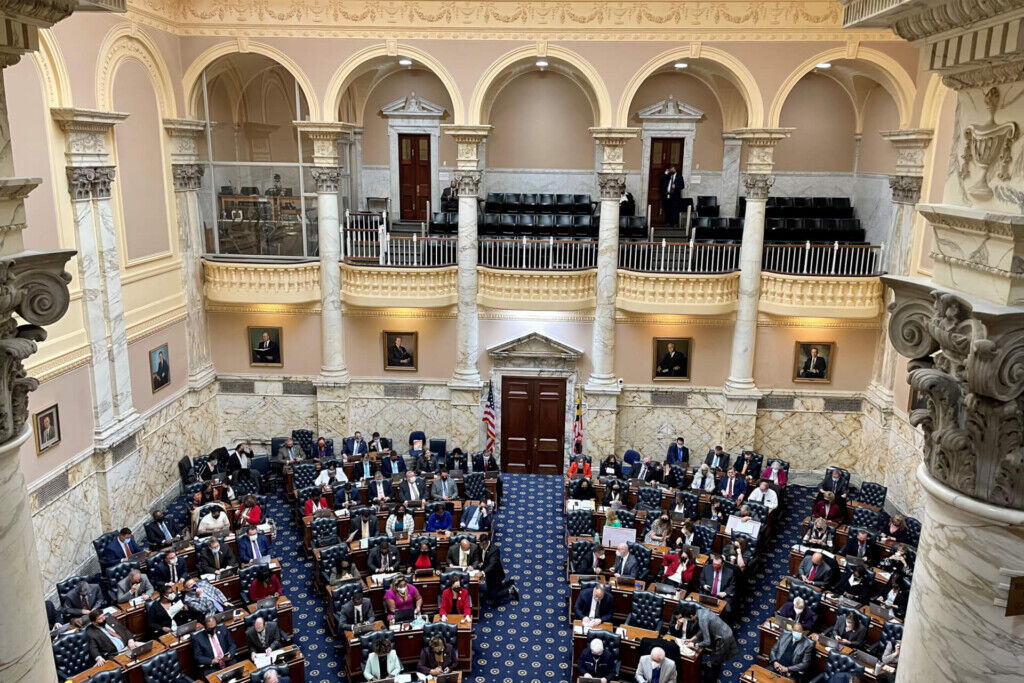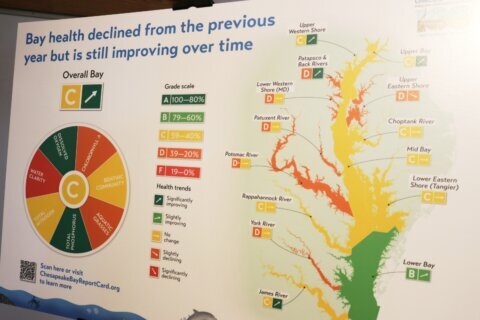This article was republished with permission from WTOP’s news partners at Maryland Matters. Sign up for Maryland Matters’ free email subscription today.

This article was written by WTOP’s news partners at Maryland Matters and republished with permission. Sign up for Maryland Matters’ free email subscription today.
In spite of soaring COVID-19 infections and hospitalizations, the Maryland General Assembly’s pandemic safety protocols are shaping up to be much different — and more publicly accessible in some ways — than what occurred during the 2021 session.
The public will be allowed in the State House and House and Senate office buildings, and lawmakers will be able to welcome visitors to their offices on a limited basis. But hearings will still be held virtually — for at least a month in the Senate, and possibly for the entire three-month session in the House.
Last year, the public was banned from legislative buildings and all hearings were held virtually. Senators sat on the Senate floor in plexiglass pods that were enclosed on three sides; delegates were split between the House chamber and an annex in a House building across the street.
This year’s General Assembly session begins at noon on Wednesday.
“It is my goal that the Senate of Maryland allows as much public access as is safely possible,” Senate President Bill Ferguson (D-Baltimore City) wrote in a memo to colleagues Wednesday.
Lobbyists and advocates said they are grateful to Ferguson and House Speaker Adrienne A. Jones (D-Baltimore County) for literally and figuratively reopening the legislature’s doors.
Gerard E. Evans of Annapolis-based lobbying firm Evans and Associates said he understands that last session’s public limitations were rooted in science and safety. But he called his firm’s ability to go into buildings in person again — albeit “masked face-to-face“ — during the 2022 legislative session “a giant leap forward.”
“It’s not just the sniffles for some people, so I get the safety angle, but I’m just really pleased about where we’re headed,” Evans said during a phone interview.
“Last year was difficult for everyone — legislators included,” Brian Frazee, the newly elected president of the Maryland Government Relations Association, said. “It certainly changed how advocates had to lobby.”
Evans touted the public access provided by the virtual nature of last year’s session as a good thing, but “to be able to sit there and figure out if you’re making any headway by body language cues is very important,” he said.
“We just look forward to a day where we can take the mask off” and have unrestricted access, said Evans, adding that there’s a light at the end of the tunnel.
“Hopefully it’s not a train,” he quipped.
Frazee, vice president of government affairs for the Maryland Hospital Association, said the state is in a much better position to battle the virus than it was at the start of the 2021 session.
If the public health metrics allow for more access, he said, “I think I speak for everyone when I say we’ll be very pleased with that.”
Here are some tips for navigating the 90-day session:
Just how accessible will the State House be at the start of the session?
Constituents and the press will be able to watch floor sessions from designated seating in the galleries of the House and Senate chambers. The Senate will also allow a limited number of reporters on the chamber floor.
The Senate plans to meet on the floor five days a week with the understanding that, on occasion, sessions may be pro forma.
Pro forma sessions include only the presiding officer and leadership of both the majority and minority parties.
The House chamber will not have an annexed space as it did during the 2021 session but will continue to seat some of its members in the gallery.
Jeremy P. Baker, Jones’ new chief of staff, said after opening day, the House will only convene in pro forma sessions to introduce bills for the first few weeks to try to beat the COVID surge projected in January and early February.
What about the House and Senate offices?
Both office buildings will be open to the public this session.
Lawmakers may have guests in their personal offices, but the Senate is limited to four guests at a time.
House standing committees will begin to meet on Jan. 13. All House committee work, including voting sessions, will be done virtually but that is subject to change based on COVID-19 trends.
Senate standing committees will meet virtually from the start of the session through Feb. 11. At that point, committees will hold their hearings in person — though those sessions will be available for viewing on livestream.
Senate committee voting sessions, however, which will also take place in person, will not be live-streamed. The public will regain in-person access to Senate committee hearings and voting sessions after Feb. 14. The press has access to Senate committee rooms beginning at the start of the session.
Once hearings begin in person, public seating in Senate committee rooms will be prioritized for people who have signed up to testify on bills. Seating will be appropriately spaced, and each room will have an air purifier.
The House will not be hosting receptions, large gatherings or committee dinners in the House office building.
Senate standing committee chairs have been given the discretion to decide if they will hold dinners and receptions, but are encouraged to keep all events virtual until Feb. 14.
I want to testify on a bill. How do I sign up?
Witnesses must sign up to testify on both House and Senate bills through the Maryland General Assembly website between 10 a.m. and 3 p.m. two business days before their bill hearing. If they have been selected to testify, they will receive a Zoom link the night before the hearing.
House committees will allow up to 50 witnesses per bill. There is no official witness limit for the Senate.
Beginning Feb. 14, Senate witnesses will begin testifying in person. At that time, sign-up will occur one business day ahead of the bill’s hearing starting at 4 p.m. and will close at 10 a.m. on the day of the hearing.
Written testimony can be submitted through the General Assembly’s website.
How will lawmakers stay protected from the virus?
Masking is required in both chambers and in the Senate and House offices at all times.
The House will adhere to guidelines put forth by the Maryland Department of Health should someone be exposed or return a positive test.
“We’ll continue to follow [CDC], MDH and local health officer advice,” Baker said in a text.
All senators and their staff members — even those working remotely — must be vaccinated or submit to weekly testing. This doesn’t include the booster, but staff that participated in the $100 vaccine incentive program are required to be boosted when they are eligible.
Senate lawmakers and staff are required to download the Maryland General Assembly COVID-19 screening app to access the legislative complex.
Senators who return a positive test are to contact the office of the Senate president and the legislature’s human resources department. Positive staff will alert their supervisors and the human resources department.
‘We must do better than this’
While many advocates are excited that the General Assembly is reopening its doors to the public this session, some are frustrated at the Senate’s decision to backslide by ceasing to livestream committee voting sessions in mid-February.
Common Cause Maryland, the ACLU of Maryland, CASA, the League of Women Voters of Maryland, the Baltimore City chapter of the NAACP and the Maryland-Delaware-D.C. Press Association issued a joint statement Friday afternoon, calling on Jones and Ferguson to improve the House and Senate pandemic protocols.
“The public health crisis forced the legislature to take steps to establish a more open and accessible process. But these changes should have been implemented long before the pandemic,” Joanne Antoine, the executive director of Common Cause Maryland, said in a statement. “The newest Senate protocols will roll back this level of access after 30 days.”
For both chambers, the coalition made several recommendations, including:
- Making fiscal and policy notes for all bills available on the General Assembly website prior to the two-day testimony sign-up window;
- Providing assistance for non-English speakers attempting to sign up to testify, and having interpreters on-hand;
- Requiring all lawmakers to be visible on camera and clearly audible at all times;
- Giving the public access to written testimony in real-time rather than at the end of hearings; and
- Requiring registered lobbyists to adhere to the same COVID-19 restrictions placed on the public.
But the Senate’s protocols, which the coalition called “confusing” in its news release, were subject to a different set of recommended changes, including continuing to stream all committee hearings and voting sessions, as was the policy during the 2021 session.
“Those who can’t come to Annapolis will be excluded from the legislative process,” Antoine said. “As COVID-19 numbers continue to rise, it will be difficult for many people who are considered high risk to participate. We must do better than this.”







